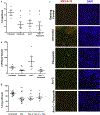Endothelial cell derived angiocrine support of acute myeloid leukemia targeted by receptor tyrosine kinase inhibition
- PMID: 26189107
- PMCID: PMC9234949
- DOI: 10.1016/j.leukres.2015.05.015
Endothelial cell derived angiocrine support of acute myeloid leukemia targeted by receptor tyrosine kinase inhibition
Abstract
In acute myeloid leukemia (AML), refractory disease is a major challenge and the leukemia microenvironment may harbor refractory disease. Human AML cell lines KG-1 and HL-60 expressed receptors also found on endothelial cells (ECs) such as VEGFRs, PDGFRs, and cKit. When human AML cells were co-cultured with human umbilical vein endothelial cells (HUVECs) and primary bone marrow endothelial cell (BMECs), the AML cells were more resistant to cytarabine chemotherapy, even in transwell co-culture suggesting angiocrine regulation. Primary BMECs secreted significantly increased levels of VEGF-A and PDGF-AB after exposure to cytarabine. Pazopanib, a receptor tyrosine kinase inhibitor (RTKI) of VEGFRs, PDGFRs, and cKit, removed EC protection of AML cells and enhanced AML cell sensitivity to cytarabine. Xenograft modeling showed significant regression of AML cells and abrogation of BM hypervascularity in RTKI treated cohorts. Together, these results show direct cytotoxicity of RTKIs on AML cells and reversal of EC protection. Combining RTKIs with chemotherapy may serve as promising therapeutic strategy for patients with AML.
Copyright © 2015 The Authors. Published by Elsevier Ltd.. All rights reserved.
Conflict of interest statement
Conflict of interest statement
The authors declare no conflict of interest.
Figures



Similar articles
-
Coculture in vitro with endothelial cells induces cytarabine resistance of acute myeloid leukemia cells in a VEGF-A/VEGFR-2 signaling-independent manner.Biochem Biophys Res Commun. 2022 Jan 8;587:78-84. doi: 10.1016/j.bbrc.2021.11.090. Epub 2021 Nov 27. Biochem Biophys Res Commun. 2022. PMID: 34872003
-
GLI1 reduces drug sensitivity by regulating cell cycle through PI3K/AKT/GSK3/CDK pathway in acute myeloid leukemia.Cell Death Dis. 2021 Mar 3;12(3):231. doi: 10.1038/s41419-021-03504-2. Cell Death Dis. 2021. PMID: 33658491 Free PMC article.
-
Cross-talk between leukemic and endothelial cells promotes angiogenesis by VEGF activation of the Notch/Dll4 pathway.Carcinogenesis. 2013 Mar;34(3):667-77. doi: 10.1093/carcin/bgs386. Epub 2012 Dec 13. Carcinogenesis. 2013. PMID: 23239744
-
Vascular endothelial growth factor signaling in acute myeloid leukemia.Cell Mol Life Sci. 2013 Apr;70(8):1307-17. doi: 10.1007/s00018-012-1085-3. Epub 2012 Jul 26. Cell Mol Life Sci. 2013. PMID: 22833169 Free PMC article. Review.
-
Molecular mechanisms of signal transduction: epidermal growth factor receptor family, vascular endothelial growth factor family, Kit, platelet-derived growth factor receptor, Ras.J BUON. 2007 Sep;12 Suppl 1:S83-94. J BUON. 2007. PMID: 17935283 Review.
Cited by
-
Harnessing upregulated E-selectin while enhancing SDF-1α sensing redirects infused NK cells to the AML-perturbed bone marrow.Leukemia. 2024 Mar;38(3):579-589. doi: 10.1038/s41375-023-02126-1. Epub 2024 Jan 5. Leukemia. 2024. PMID: 38182818 Free PMC article.
-
7‑Difluoromethyl‑5,4'‑dimethoxygenistein exerts anti‑angiogenic effects on acute promyelocytic leukemia HL‑60 cells by inhibiting the TLR4/NF‑κB signaling pathway.Mol Med Rep. 2020 May;21(5):2251-2259. doi: 10.3892/mmr.2020.11029. Epub 2020 Mar 18. Mol Med Rep. 2020. PMID: 32186776 Free PMC article.
-
Myeloid malignancies and the microenvironment.Blood. 2017 Feb 16;129(7):811-822. doi: 10.1182/blood-2016-09-670224. Epub 2016 Nov 15. Blood. 2017. PMID: 28064238 Free PMC article.
-
Conversation before crossing: dissecting metastatic tumor-vascular interactions in microphysiological systems.Am J Physiol Cell Physiol. 2022 Nov 1;323(5):C1333-C1344. doi: 10.1152/ajpcell.00173.2022. Epub 2022 Sep 19. Am J Physiol Cell Physiol. 2022. PMID: 36121131 Free PMC article. Review.
-
Mesenchymal Stem and Progenitor Cells in Normal and Dysplastic Hematopoiesis-Masters of Survival and Clonality?Int J Mol Sci. 2016 Jun 27;17(7):1009. doi: 10.3390/ijms17071009. Int J Mol Sci. 2016. PMID: 27355944 Free PMC article. Review.
References
-
- Lowenberg B, Downing JR, Burnett A, Acute myeloid leukemia, New Engl. J. Med. 341 (14) (1999) 1051–1062. - PubMed
Publication types
MeSH terms
Substances
Grants and funding
LinkOut - more resources
Full Text Sources
Medical

